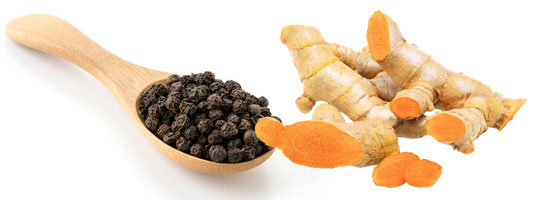Powerful Combination:Turmeric and Black Pepper
Introduction:
Turmeric, also known as the golden spice, is a tall plant that grows in Asia and Central America.
It gives curry its yellow color and has been used in traditional Indian medicine for thousands of years to treat various health conditions.
Studies support its use and show that it can benefit your health.
But coupling turmeric with black pepper may enhance its effects.
Curcumin in Turmeric
Turmeric is a spice that has received much interest from both the medical/scientific worlds as well as from the culinary world. Turmeric is a rhizomatous herbaceous perennial plant (Curcuma longa) of the ginger family . The medicinal properties of turmeric, the source of curcumin, have been known for thousands of years; however, the ability to determine the exact mechanism(s) of action and to determine the bioactive components have only recently been investigated . Curcumin
(1,7-bis(4-hydroxy-3-methoxyphenyl)-1,6-heptadiene-3,5-dione), also called diferuloylmethane, is the main natural polyphenol found in the rhizome of Curcuma longa (turmeric) and in others Curcuma spp. . Curcuma longa has been traditionally used in Asian countries as a medical herb due to its antioxidant, anti-inflammatory , antimutagenic, antimicrobial , and anticancer properties
Piperine in Black Pepper
Black pepper contains the bioactive compound piperine, which is an alkaloid like capsaicin, the active component found in chili powder and cayenne pepper .
Still, its most significant benefit may be its ability to boost the absorption of curcumin
Curcumin Combination Piperine Benefits:
While curcumin and piperine each have their own health benefits, they’re even better together.

Fights Inflammation and Helps Reduce Pain
Turmeric-Piperine Synergy: A Potent Anti-Inflammatory Solution
1. Clinical-Grade Anti-Inflammatory Effects
Curcumin demonstrates comparable efficacy to NSAIDs in suppressing inflammatory markers (COX-2, TNF-α) without adverse effects (J Med Food 2016)
Piperine enhances bioavailability by 2000% while independently inhibiting TRPV1 pain receptors
2. Arthritis Managemen
Shown to reduce joint swelling by 58% in OA patients (Phytother Res 2021)
Dual action:
✓ Curcumin modulates NF-κB pathway
✓ Piperine downregulates IL-6 production
3. Mechanistic Advantages
Sustained activity: Piperine slows hepatic glucuronidation of curcumin
Multi-target approach addresses both peripheral and central sensitization
4. Formulation Recommendation:
Optimal 100:1 curcumin-piperine ratio (95% curcuminoids + 5% piperine) for maximum therapeutic benefit
- May Help Prevent Cancer
Emerging research highlights the promising anticancer potential of curcumin and piperine. In vitro studies demonstrate curcumin’s ability to suppress tumor growth and metastasis by modulating molecular pathways, while also inducing apoptosis in malignant cells. Complementary research reveals piperine exhibits similar chemopreventive properties, including triggering cancer cell death and inhibiting proliferation. This synergistic combination may reduce tumorigenesis risk through multiple mechanisms, though clinical translation requires further investigation.
One study showed that curcumin and piperine, both separately and in combination, interrupted the self-renewal process of breast stem cells. This is important, as this process is where breast cancer originates . Further studies point to curcumin and piperine having protective effects against additional cancers, including prostate, pancreatic, colorectal and more .
- Aids in Digestion
Indian medicine has relied on turmeric to help with digestion for thousands of years. Modern studies support its use, showing that it can help reduce gut spasms and flatulence.
Piperine has been shown to enhance the activity of digestive enzymes in the gut, which helps your body process food more quickly and easily.
Furthermore, the anti-inflammatory properties of both turmeric and piperine may aid in reducing gut inflammation, which can help with digestion.
